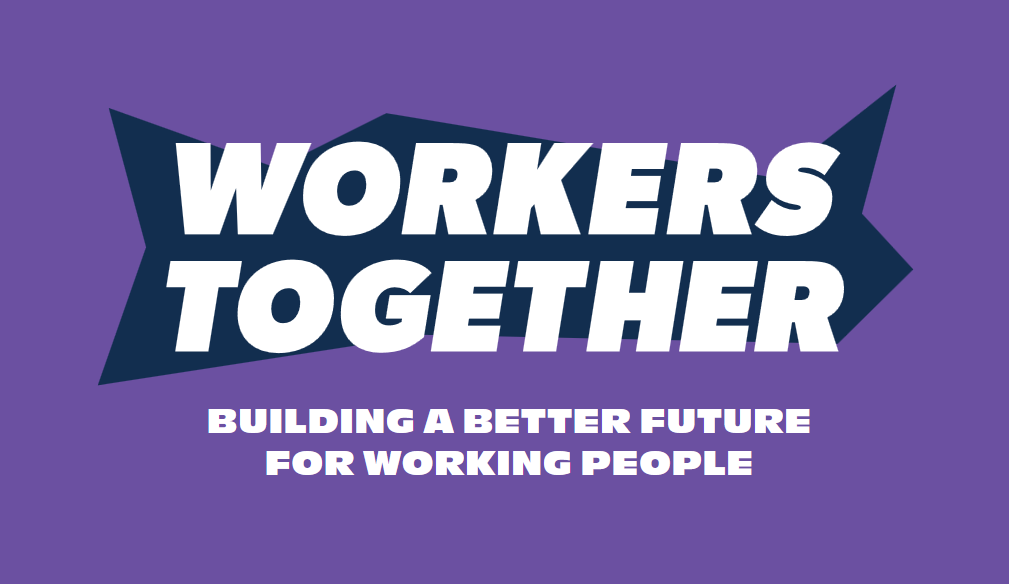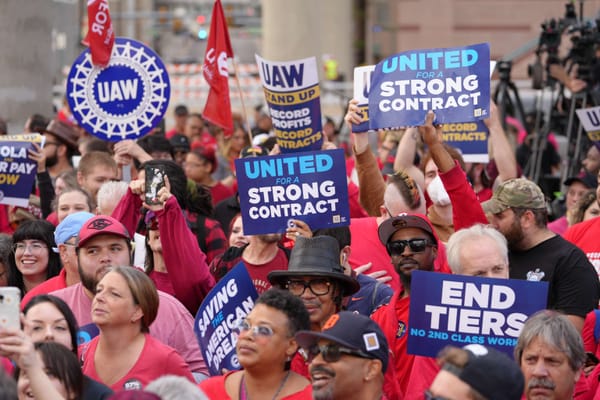
Election 44 is in full swing, and we now have party platforms from the Liberals, Conservatives and the NDP. The three parties are all making their various pitches to workers, mostly disingenuously in the case of the Liberals and Conservatives, I would argue.
On the labour front, perhaps the most noteworthy development this week was the surprising inclusion of a call for “anti-scab” legislation in the Liberal Party’s recently released platform.
Anti-scab legislation bans employers from hiring or using replacement workers — “scabs” — during a strike or a lockout. Like most Liberal proposals, it’s instructive to read the fine print on this one.
Because this current anti-scab law is being proposed federally — while labour relations and employment standards are mostly regulated provincially — the Canada Labor Code amendment would only apply to the approximately 910,000 people who work in the federally-regulated private sector, around 34 per cent of whom are union members. The law would cover unionized workers in air, rail and interprovincial road transportation, banking and telecommunications, some mining and natural resources, international shipping, as well as some First Nations band government workplaces.
Even though it would have relatively limited jurisdictional reach, meaningful federal anti-scab legislation would, nevertheless, be an important reform. But just how meaningful a Liberal version of anti-scab law would be deserves scrutiny.
Historically, hiring scabs has been a highly provocative way for bosses to undermine the power of striking workers. The withdrawal of labour is how unionized workers exercise their collective power. In many industries, a picket line that halts or substantially impedes production can be the difference maker in a strike. By allowing employers to simply replace striking workers, union leverage is nullified. If a boss can employ scabs, there’s very little incentive for that employer to bargain in good faith.
The use of scabs also increases the likelihood of violence on picket lines, generates tension in communities experiencing a strike or lockout and generally harms long-term labour relations. Moreover, employers frequently hire private security firms and obtain court injunctions to ensure scabs are able to freely enter struck workplaces without union interference.
We should, however, be careful to not present anti-scab laws as a neutral “win-win” for labour relations. Many anti-scab proponents, including some unions, will emphasize how such legislation can reduce the number of days lost to labour disputes. The corollary here is that this ultimately increases overall productivity.
However, employers don’t fight against the introduction of anti-scab laws because they’re against greater ‘productivity;’ they resist these laws because they want the ability to use their capital as they please, including hiring scabs during a strike.
There’s no ideological advantage to anti-scab proponents obscuring the fact that workers and bosses have conflicting class interests at work.
Presently, anti-scab legislation is on the books only in British Columbia and Quebec, though even in these two jurisdictions, legislative loopholes allow scabs under some circumstances. For example, managers can perform certain work during a strike in Quebec, and members of the bargaining unit on strike can cross the picket line and work in B.C.
The Liberals’ proposed anti-scab law is silent on this issue of “internal” scabs, i.e. whether members of a union on strike or locked out are permitted to cross the picket line and undermine their own colleagues, as in B.C.
In May of this year, Unifor, Canada’s largest private sector union, launched a national campaign for anti-scab legislation at the federal and provincial levels, along with a report entitled, “Fairness on the Line: The case for anti-scab legislation in Canada.” Unifor’s report provides some suggestive, though far from comprehensive, data.
Unifor’s records indicate that, between 2013 and 2020, the average strike/lockout length when scabs were involved was about 265 days, compared to about 42 days without scabs. Unifor’s three longest strikes since 2013 all involved the use of scabs.
The launch of Unifor’s national campaign comes on the heels of the contentious lockout of Local 594 members at the Co-op Refinery in Regina. During this nearly seven-month long dispute, the refinery used scab labour to continue production, while employing security personnel to facilitate the movement of scabs and intimidate workers on the picket line.
Unifor tweeted in support of the Liberal platform proposal, failing to note, however, that the plan calls for banning “scabs” only during employer-initiated lockouts, not during strikes.
The fine print I mentioned earlier: this is it.
This “lockout” caveat means that if an employer locks workers out after a collective bargaining impasse, the former could not bring in replacement workers. But if the workers democratically voted to strike, the boss could still replace them with scabs. As Unifor’s own report indicates, the use of scabs is much more common during strikes than lockouts.
The Liberal proposal is thus “anti-scab” legislation in name only. However, this shouldn’t surprise anyone, given the Liberals’ track record on this issue, and on labour relations in general.
While in the opposition, Justin Trudeau voted in favour of anti-scab legislation introduced by the Bloc Québecois in 2009. The Bloc largely support anti-scab laws out of a desire to strengthen the political alliance between labour and sovereigntists in Quebec — and because provincially-regulated union members in the province already have anti-scab protection. This particular bill failed on second reading. Prior to this, the Liberals have flip-flopped on other attempts to implement anti-scab laws federally.
However, since the Liberals formed government in 2015, they have voted down similar legislation unceremoniously.
When, in 2016, NDP MP Karine Trudel introduced Bill C-234, a private member’s bill that would have revised the Canada Labour Code to prevent the use of scabs, all but five Liberal MPs voted against the bill, or didn’t vote on it.
At the time, Unifor decried this vote as “a betrayal of working people across this country.” This “betrayal,” however, did not prevent the union from endorsing the Liberals in 2019 as part of their broader ‘strategic voting’ efforts, ostensibly meant to keep Conservatives out of Parliament.
One apparent sticking point with the 2016 legislation involved its proposed financial penalties for employers who defy the law and use replacement workers. Nickel Belt Liberal MP, Marc Serré, claimed that these new fines were incompatible with the Canada Labour Code, a strange objection given that the bill was intended to amend it.
Interestingly, the new Liberal platform commitment to anti-scab legislation makes no mention of financial or administrative penalties for those firms who violate the law, which begs the question of how they plan to ensure employer compliance with it. The paucity of meaningful deterrents for violations of labour and employment law in Canada is a well-researched problem.
In January 2020, NDP MP and Labour Critic, Scott Duvall announced that he would reintroduce their party’s anti-scab bill. Unifor and the Canadian Union of Public Employees (CUPE) both celebrated the reintroduction of the bill. As of the election, however, it had not been voted on.
Let’s not forget, the Liberals have not shied away from legislating striking public sector union members back to work, as they did with the Canadian Union of Postal Workers in 2018 and the CUPE Port of Montreal workers earlier this year. They are not a party that takes free collective bargaining seriously, and are certainly not concerned with augmenting the strength of the working class.
It frankly would be shocking if their anti-scab law proposal wasn’t a watered down version with little efficacy and no teeth.
Like nearly all of the Liberal platform, anti-scab legislation could have been passed in the previous parliament, and in a form that bans replacement workers during lockouts and strikes. If the Liberals are serious about only prohibiting scabs during lockouts, I hope NDP MPs will not support this.
The federal NDP’s platform calls for anti-scab legislation during strikes and lockouts, as the party did during the last election. This has long been the federal NDP’s position. However, their previous private members bills would maintain the “manager” exemption and would therefore leave open a loophole which has allowed employers in Quebec to partially get around the ban on scabs.
A strong anti-scab law would ban the use of replacement workers in strikes and lockouts, make no distinction between “internal” and “external” scabs, strictly limit what work managers can perform during a labour dispute, and impose hefty fines on employers who defy the law. Despite Unifor’s endorsement of the tepid Liberal proposal, the union’s own national campaign is calling for anti-scab laws with these stronger features.
It’s important to keep in mind, however, that even with strong anti-scab legislation, employers can still outsource work to other production facilities. Anti-scab laws prevent replacement workers from going in, but they don’t stop production from taking place elsewhere. In a neoliberalized and globalized economy, labour is constantly fighting against the mobility of capital. Anti-scab laws are one small weapon in this much larger battle.
Like so many Liberal Party proposals — especially those dealing with labour and employment — when you scratch the surface, the underlying details reveal the plan to be either underwhelming or completely disingenuous.
Unions and those on the left should make clear how limited the Liberal anti-scab proposal is, and push the NDP to make their version as strong as possible. It would be a small, but important, step in strengthening the power of labour.







